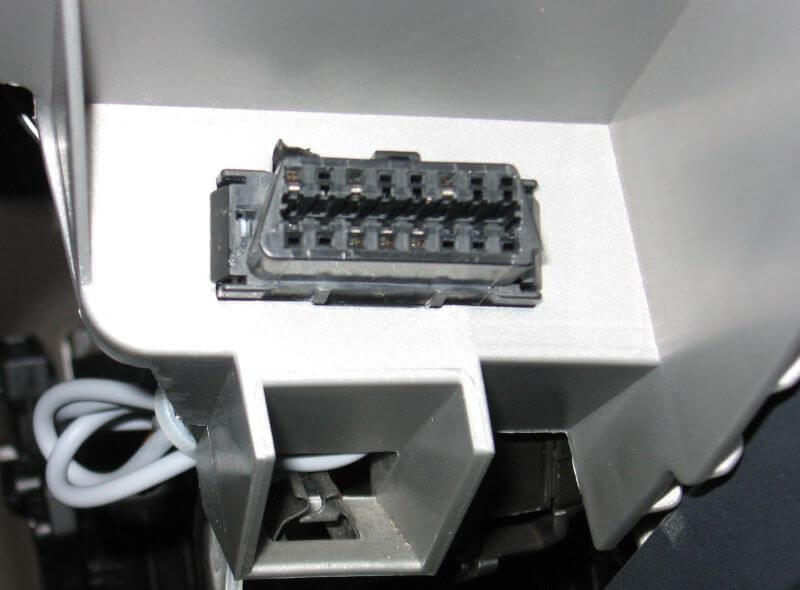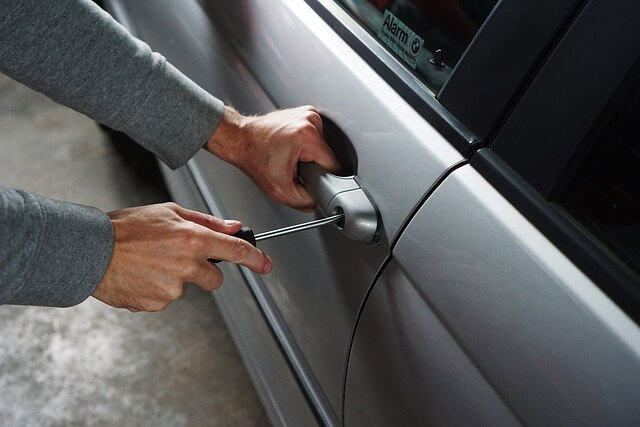The important points
- Vehicle theft has increased dramatically in Canada over the past few years, especially in Quebec and Ontario.
- The best way to protect your vehicle from theft is by adopting many layers of security, rather than relying on any one anti-theft measure.
- Car insurance covers vehicle theft, provided the owner purchased the appropriate optional coverage beforehand.
How do thieves steal cars?
To prevent your car from getting stolen, it’s important to understand how car thieves operate. From high-tech relay attacks to low-tech hijackings, car thieves have many techniques.
We won’t get too much into smash-and-grab thefts, as everyone can imagine how those work. Thieves do steal cars when the owners simply leave the keys inside, whether they wanted to leave the heat on for a minute, or they simply forgot to take the keys with them. Carjackings are another brute force method that thieves use to steal cars.
We’ll talk more about defending against these and other theft methods soon. First, a look at the high-tech methods that thieves use to steal modern, tech-loaded vehicles.
Relay attacks
You may have noticed that most vehicles don’t have physical keys anymore. Instead, keyless cars have a key fob that transmits a unique radio signal. A receiver inside the car detects this signal when the fob is nearby, unlocking the doors and disabling the engine immobilizer. Engine immobilizers prevent the engine from starting without the key present. They’ve been mandatory on vehicles sold in Canada since 2007.3
A common method for stealing keyless cars is known as a relay attack.
Thieves use a device that detects the radio signal broadcast from the key fob and copies it, retransmitting it to the car. Often, this type of theft takes place while a vehicle is parked at home. One thief stands near the house, trying to catch the signal of the key fob stored somewhere inside. The other thief stands near the car, ready to hop in and drive away as soon as they’re able to copy the signal and send it to the car.
Onboard diagnostic port attacks
The onboard diagnostic (OBD) port is a plugin inside every vehicle. It allows a mechanic to connect to the vehicle’s onboard computer to view the status of various systems. When the check engine light comes on, connecting a reader to the OBD port will show an error code pointing to the source of the issue.
OBD ports are typically located underneath the steering column, somewhere above the pedals. They look like this:

It’s possible to use the OBD port to reprogram the vehicle’s computer in various ways, too. Thieves can use the OBD port to copy or reprogram the key fob’s unique code, granting them full access to the car.
This method does require the thief to get inside the car, but a broken window is a small price to pay in exchange for stealing the whole car.
Controller area network bus attacks
The controller area network (CAN) bus is part of the electronic system within the car. Basically, it lets various components of the vehicle communicate with one another. By tapping into this system, car thieves can access the vehicle’s computer and copy the unique wireless key code onto a blank key fob, gaining access to the vehicle.
In some cases, it’s possible for a thief to access the CAN bus through the headlight — meaning they don’t even need to break into the vehicle.
12 car theft prevention tips
Now that you know how car thieves work, how can you stop them from stealing your car?
Unfortunately, there’s no perfect solution. If there were, vehicle theft rates wouldn’t be skyrocketing. The best defense against vehicle thieves is a concept known as layered protection. No single anti-theft measure will stop a thief. But if you make it as inconvenient as possible for them with many defenses working together, they may pass up your car for an easier target.
From the following list of car theft prevention tips, try to implement as many as possible.
1. Keep the doors locked and the windows closed
Let’s start with the absolute basics: don’t leave your vehicle unlocked, and don’t leave the windows open when you’re not in it. Many vehicle thefts are crimes of opportunity, with thieves simply waiting for an easy target. If they can get inside without breaking a window (and causing a scene) it makes the whole process easier.
2. Don’t leave the keys inside (or nearby)
It should go without saying that you never leave your vehicle unattended with the keys inside. But, it’s also important not to leave spare keys inside the wheel well, or anywhere else on the car or outside your house — thieves know about these hiding places.
At home, keep your key fobs as far away from the car as possible to reduce the ease of relay attacks. Keep them away from the edges of the house, too.
3. Keep your keys secure
In the same vein, consider purchasing a faraday box or pouch (also known as an RFID blocker). Keep your key fobs inside this box when they’re at home. Faraday boxes block radio signals, meaning thieves won’t be able to copy the fob’s signal for a relay attack.
Just be aware that there are many subpar RFID blockers on the market. When you buy one, you can test it by placing your cell phone inside and calling it. If the call goes through, the box isn’t blocking radio signals.
4. Park securely
Wherever possible, park your vehicle in a secure garage or a fenced-in area. Try to park in well-lit areas, too. At home, if you don’t have the option to park in a garage, install motion-sensitive security lighting in the driveway. Security cameras aren’t a bad idea either.
If you have multiple cars, use the less valuable cars to block in the more valuable ones.
5. Use the parking brake
Sometimes, car thieves simply roll up with a tow truck and haul target cars away. Engaging the parking brake any time the car is parked adds an extra annoyance they have to overcome before they can tow a vehicle away. While you’re at it, turn the wheels all the way to one side whenever you park, too.
6. Protect the VIN
The vehicle identification number (VIN) is a unique way to identify individual vehicles. Make sure you have copies of each vehicle’s VIN saved somewhere safe, just in case. While the VIN will be tied to your licence plate, it’s easier when you report the theft if you can provide a VIN, too. If the vehicle is stolen, it’s easy for thieves to swap a licence plate but much harder for them to tamper with the VIN. Police will use the VIN to identify a stolen vehicle if it’s recovered.
7. Record unique identifiers
In addition to keeping a copy of your vehicle’s VIN, keep a record of every possible identifier just in case the vehicle is stolen. Know the make, model, year, and trim level, for example, as well as the license plate number.
If your car has any unique decals or visible damage, these details can also help identify it.
Police also suggest dropping a business card inside the door panels to help police identify the owner if the vehicle is stolen and later recovered.4
8. Install a tracking system
Tracking systems both deter theft and increase the chances of recovering the vehicle if it is stolen. Like many anti-theft measures, tracking systems are not created equal. While simple devices like Apple AirTags can track the car, they’re easy to locate and disable.
Much more effective are systems like Tag. The Tag system places multiple hard-to-locate transmitters throughout the vehicle, including tiny RFID devices on specific parts that are commonly stolen.
9. Use a steering wheel lock
Steering wheel locks are simple, relatively affordable devices. On their own they may not deter a thief, but in combination with other measures they’re worth the price. Just make sure to get a quality lock, made of metal and not plastic.
You can also get pedal locks, which prevent the gas or brake pedals from being used.
10. Install an alarm system
Most vehicles have some form of built-in alarm, but adding an aftermarket alarm system can help deter thieves and may be harder to disable than the factory system.
11. Add a kill switch
A kill switch is installed inside the car, usually in a hard-to-find location. When the switch is off, the vehicle won’t start — kill switches introduce physical disruptions into the vehicle’s electrical system that no level of hacking can overcome.
Just be aware that kill switches can introduce their own issues, and can void the vehicle’s warranty.
12. Buy an OBD port lock
To prevent car thieves from accessing the vehicle’s OBD port, buy an onboard diagnostic port lock. These simple devices block access to the port.



